You are using an out of date browser. It may not display this or other websites correctly.
You should upgrade or use an alternative browser.
You should upgrade or use an alternative browser.
Cutting the neg.
- Thread starter JZASMM
- Start date
David Mullen ASC
Active member
Your EDL is used to match the video edit to the keycode / edge numbers on the cameras rolls. There are certain things that need to happen for this to be accurate (time code to keycode coordination).
Keycode is the bar code version of the negative's edge numbers that occur every couple of frames.
The video edit also has to be programmed to make sure that you take into account the frame and a half loss on each side of a picture cut that happens when you later conform the camera rolls to match the picture edit.
If you are shooting in 16mm, then usually the negative is A-B checkerboarded, meaning that every cut alternates on an A printing roll and a separate B printing roll, with black leader in between. When the A and B rolls are exposed over each other onto the print in two passes, you have a series of connected picture cuts with no frameline splice jumps. You can also incorporate fades and dissolves this way, if they were cut using standard lab lengths for the effect.
35mm negative is usually straight-cut, not checkerboarded, but fades and dissolves can still be done by using A-B rolls. See:
http://ice.prohosting.com/sampleco/keycode.htm
http://en.wikipedia.org/wiki/Negative_cutting
http://www.negativecutting.com/prepare-edit.php3
Keycode is the bar code version of the negative's edge numbers that occur every couple of frames.
The video edit also has to be programmed to make sure that you take into account the frame and a half loss on each side of a picture cut that happens when you later conform the camera rolls to match the picture edit.
If you are shooting in 16mm, then usually the negative is A-B checkerboarded, meaning that every cut alternates on an A printing roll and a separate B printing roll, with black leader in between. When the A and B rolls are exposed over each other onto the print in two passes, you have a series of connected picture cuts with no frameline splice jumps. You can also incorporate fades and dissolves this way, if they were cut using standard lab lengths for the effect.
35mm negative is usually straight-cut, not checkerboarded, but fades and dissolves can still be done by using A-B rolls. See:
http://ice.prohosting.com/sampleco/keycode.htm
http://en.wikipedia.org/wiki/Negative_cutting
http://www.negativecutting.com/prepare-edit.php3
David Mullen ASC
Active member
What do you mean by "picture put back to film"? It's already on film -- it's always been on film. You're just cutting a video transfer of the film.
Do you mean a digital intermediate where a digital scan is recorded to film?
Are you asking how you sync the final sound mix to picture when you edited using 60i NTSC transfers of 24 fps material, and cut the sound to that video copy, and then cut the negative to match the video edit?
A lot of it has to do with cutting in a 24-frame environment, basically by eliminating the 3:2 pulldown in the NTSC transfers in order to get back to the true frames.
The only sync issues come from the fact that NTSC transfers slow the film speed down from 24 fps to 23.976 fps, so once the sound has been edited and even mixed at 23.976 fps because the sound people are working with NTSC copies of the final cut, at some point the speed has to be adjusted to match the 24 fps film.
Sometimes they will make a silent answer print off of the cut negative, take it to a mix stage, and see how it syncs with the final sound mix so they can adjust the sync if necessary. Then the final mix is set in some form or another to the company making the sound negative used to put the soundtrack on the print.
We're getting to a point where you need to read some textbooks to answer these questions more thoroughly.
Do you mean a digital intermediate where a digital scan is recorded to film?
Are you asking how you sync the final sound mix to picture when you edited using 60i NTSC transfers of 24 fps material, and cut the sound to that video copy, and then cut the negative to match the video edit?
A lot of it has to do with cutting in a 24-frame environment, basically by eliminating the 3:2 pulldown in the NTSC transfers in order to get back to the true frames.
The only sync issues come from the fact that NTSC transfers slow the film speed down from 24 fps to 23.976 fps, so once the sound has been edited and even mixed at 23.976 fps because the sound people are working with NTSC copies of the final cut, at some point the speed has to be adjusted to match the 24 fps film.
Sometimes they will make a silent answer print off of the cut negative, take it to a mix stage, and see how it syncs with the final sound mix so they can adjust the sync if necessary. Then the final mix is set in some form or another to the company making the sound negative used to put the soundtrack on the print.
We're getting to a point where you need to read some textbooks to answer these questions more thoroughly.
David Mullen ASC
Active member
Assuming your reversal original had edgecode information, sure, you could do that. Reversal print stock has disappeared though, so I'm not sure what you are planning on doing with the cut reversal original -- I guess you could optically make a dupe negative from it.
Similar threads
- Replies
- 0
- Views
- 253
- Replies
- 2
- Views
- 1,713
- Replies
- 0
- Views
- 1,650
- Replies
- 0
- Views
- 1,905
- Replies
- 0
- Views
- 5,453




